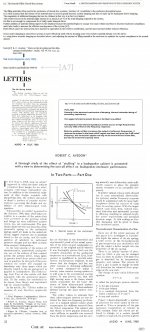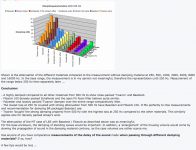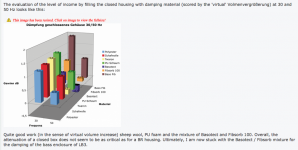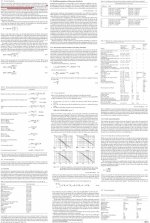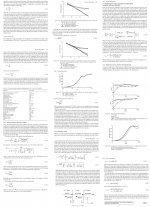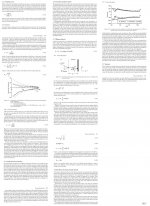Hi. What's the simple science behind stuffing with polyfill the enclosure in order to improve potential/performance? I am not ok with that shitty explanation that simply says that the driver sees a bigger enclosure after fiber stuffing, therefore the performance is increased, thing that always occur with a bigger chamber.
Having more imagination than knowledge, I tried to imagine what really happens inside there once the enclosure is stuffed with fibers.
I think that the polyfill affects so bad the high frequency waves, trapping and dissipating them, letting alive only the low frequencies. So now because low frequencies have no more competition, they have a more pure process of creation and evolution, resulting the enclosure in an improved bass machine that creates stronger low waves.
Having more imagination than knowledge, I tried to imagine what really happens inside there once the enclosure is stuffed with fibers.
I think that the polyfill affects so bad the high frequency waves, trapping and dissipating them, letting alive only the low frequencies. So now because low frequencies have no more competition, they have a more pure process of creation and evolution, resulting the enclosure in an improved bass machine that creates stronger low waves.
I always thought it was there to absorb possible enclosure vibrations as well has remove any possible rear speaker audio (echo) from vented ports.
That was my understanding...
Vin
What I observed, is that this technique "raw stuffing" is more used on sealed subs, in ported enclosures people tend to use those fiber sheets glued onto the walls, I think that otherwise, if they fill it as you usually do on sealed enclosures, you would affect the air speed, being in this case very important because a port participation in the system, I initially thought that they avoided that stuffing technique just because the material can be drained through the port, thing that you can solve using a mesh or wires, but then I thought about the port air speed.
So you are saying that the performance or sound quality is improved because we changed the speed of sound with the filling stuff? can you explain it? it is easier for me for example to imagine the fibers weakening the high frequency.
Basically, the stuffing ( especially on the walls and corners ) converts air pressure into heat so there's some energy conversion.
The resultance of the membrane that "sees" a bigger volume because of the stuffing is that the inner walls are "seen" farther.
Inside of a box there is no high or low frequency, just pressure so the argument must be treated with aerodynamics rather with acoustic.
In subwoofer boxes as in BR for mid-woofers the filling/stuffing it's not mandatory; in subwoofers in particular, theoretically there is no need for stuffing.
The resultance of the membrane that "sees" a bigger volume because of the stuffing is that the inner walls are "seen" farther.
Inside of a box there is no high or low frequency, just pressure so the argument must be treated with aerodynamics rather with acoustic.
In subwoofer boxes as in BR for mid-woofers the filling/stuffing it's not mandatory; in subwoofers in particular, theoretically there is no need for stuffing.
DIY Loudspeaker Projects Troels Gravesen
Have a look at the stuffing and port tuning pages in there ^^^.
J.
Have a look at the stuffing and port tuning pages in there ^^^.
J.
So you are saying that the performance or sound quality is improved because we changed the speed of sound with the filling stuff? can you explain it? it is easier for me for example to imagine the fibers weakening the high frequency.
Bob Brine's observations show that the speed of sound is not really changed by fiberfill, which is important to note. Many people think that sound waves are slowed down by the fiberfill, which naturally makes you think the waves take longer to get through the fill and back, and is the reason the enclosure volume appears larger to the driver.
Have you ever seen or been in an anechoic chamber? If you haven't, look it up and The treatments on the walls are meant to absorb or dampen acoustic (or electromagnetic depending on the treatments) energy, not reflect it, over a certain range of frequencies. To some extent, the fiberfill does this. How much absorption and what frequency range depends on the properties of the fiberfill and how densely it is packed.
Last edited:
Attachments
I think that the polyfill affects so bad the high frequency waves, trapping and dissipating them, letting alive only the low frequencies. So now because low frequencies have no more competition, they have a more pure process of creation and evolution, resulting the enclosure in an improved bass machine that creates stronger low waves.
That's clear as mud, let me add a bit more:
"Lorem ipsum dolor sit amet, consectetur adipiscing elit, sed do eiusmod tempor incididunt ut labore et dolore magna aliqua. Ut enim ad minim veniam, quis nostrud exercitation ullamco laboris nisi ut aliquip ex ea commodo consequat. Duis aute irure dolor in reprehenderit in voluptate velit esse cillum dolore eu fugiat nulla pariatur. Excepteur sint occaecat cupidatat non proident, sunt in culpa qui officia deserunt mollit anim id est laborum"
That's clear as mud, let me add a bit more:
https://en.wikipedia.org/wiki/Four_stages_of_competence
The better response to someone at lower stages is to teach them, not to deride.
For those who aren't familiar, the "Lorem ipsum..." is nonsensical filler text used in developing a format for a document so that viewers will focus on format rather than content.
http://www.kirchner-elektronik.de/~kirchner/Speaker_Development.pdf
Starting on Page 50(W5.3)
Studying the enclosure lately - Thought this might add something to the topic here.
Starting on Page 50(W5.3)
Studying the enclosure lately - Thought this might add something to the topic here.
As bjorno has linked, the relation between apparent box size and stuffing is a known mechanism. If you have no stuffing, the air in the box compresses adiabatically where p(v^1.4)=c and the air heats and cools slightly during compression and expansion.
Adding stuffing at the critical amount gives a large amount of surface area for the air to transfer heat to, making it an isothermal process that behaves with pv=c.
Adding stuffing at the critical amount gives a large amount of surface area for the air to transfer heat to, making it an isothermal process that behaves with pv=c.
... but polyester fibers are the worst material according to tests done by a German magazine.
Hi Andersonix,
Disagree..The Text and Questions made are inconclusive for someone that work with Damping Materials Daily.
b
Attachments
- Status
- This old topic is closed. If you want to reopen this topic, contact a moderator using the "Report Post" button.
- Home
- Loudspeakers
- Subwoofers
- What's the simple science behind polyfill stuffing? My explanation as well.
